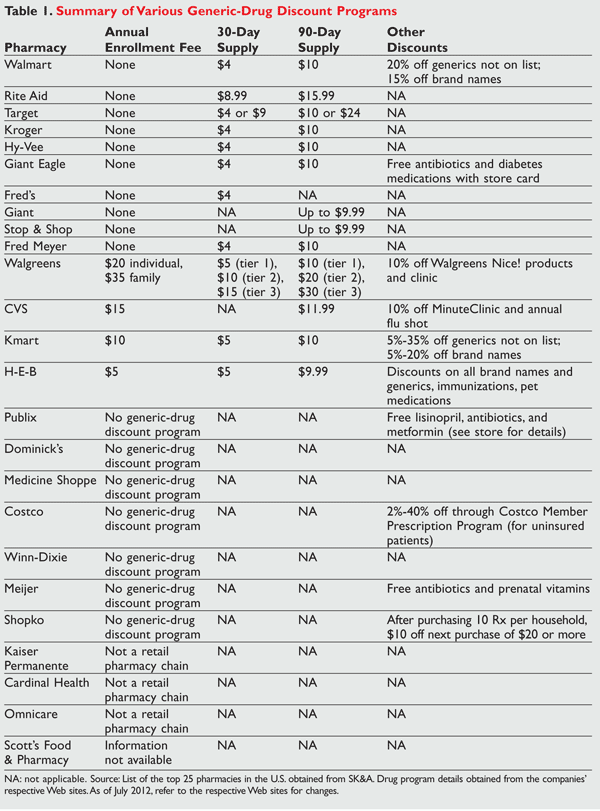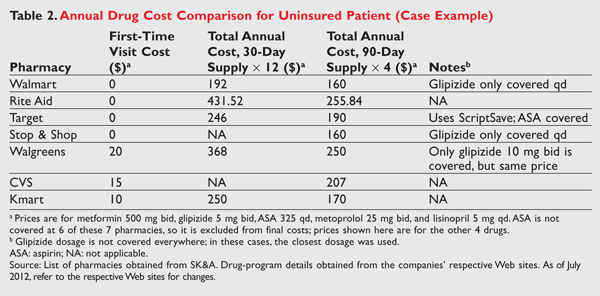The CDC estimates that 50% of Americans are taking at least one prescription medication.1 It was estimated in 2010 that 49.9 million Americans (16.3%) were uninsured, a number that has increased in the current economic climate.2 Every day, countless uninsured patients are admitted to the hospital for ailments that, once acutely treated, require medications to be taken on a permanent basis, with many therapies initiated in the hospital setting. Medication costs are a major contributor to the likelihood of patient compliance and should be taken into account when therapy decisions are being made.3
Generic-Drug Discount Programs
The effects of medication-assistance programs have been investigated, with promising results that point to increased access to prescription medication and promotion of adherence.4,5 A medication-assistance program for indigent patients was conducted through the collaborative effort of pharmacists and social workers at a university medical center. The use of various sources of assistance in this program improved patient access to medication and resulted in a substantial cost savings to the institution.4 A separate program that used grant funding to provide access to free or low-cost medication to indigent patients yielded similar results.5
Since 2006, various chain community pharmacies have offered generic-drug discount programs (GDDPs) to bolster generic-drug utilization following the surge of generic-drug availability in the U.S. prescription market.6,7 Recently, the prevalence of community pharmacy GDDP usage was investigated over a 2-year period. The study found that there was an increase in the use of these programs, especially among patients taking multiple prescriptions.8
Many generic drugs available on the market are incorporated into GDDPs. For instance, approximately 40% of the top 200 generics (from the Drug Topics list of 2010 top 200 generic drugs by total prescriptions) were found on Walmart’s generic discount list.9 The drug categories for these 80 drugs included cardiovascular and antidiabetic agents, analgesics, antidepressants, and antibiotics. Some GDDPs charge an enrollment fee; additionally, the various GDDPs differ in their respective 30-day and 90-day supply costs (TABLE 1). The choice of GDDP is complicated by the fact that patients may bear the additional cost burden of imposed fees. Moreover, patients may have limited access to a particular pharmacy that would provide them with the optimal cost savings based on their individual drug therapy. In other words, one size does not fit all.

Cost Comparison
Case Example: AB is an uninsured patient being discharged after receiving stents post myocardial infarction. His medical history is significant for diabetes and coronary artery disease. AB’s discharge medications are as follows: metformin 500 mg twice daily, glipizide 5 mg twice daily, aspirin 325 mg daily, metoprolol tartrate 25 mg twice daily, lisinopril 5 mg daily, and clopidogrel (Plavix) 75 mg daily. AB will receive a 2-week supply from the hospital while his application for free clopidogrel from the manufacturer is being processed. All of these medications are listed in many GDDPs. A summary of the out-of-pocket cost to AB is given in TABLE 2 .

The selected pharmacies were chosen based on AB’s geographic proximity. In this example, a specific chain pharmacy allowed for an apparent greater cost savings for AB. However, such cost savings will not necessarily be duplicated—it depends upon the individual patient’s medications and GDDP offers.
Conclusion
Although studies provide a closer look at GDDPs, they do not indicate which program provides the greatest cost savings for patients throughout the country. A detailed analysis of the differences between GDDPs can lead to the opportunity to ensure that uninsured patients everywhere can reduce their spending on prescriptions, which could lead to increased compliance and improved outcomes.
ACKNOWLEDGMENTS: The authors wish to thank Amanda Manfredo and Esther Yoon, PharmD Candidates 2013, for creating summary charts of various pharmacy generic-drug discount programs, and Danielle Ezzo, PharmD, CGP, BCPS, for guidance and insight.
DISCLAIMER: The authors have no affiliations with any of the listed pharmacies and have no disclosures to report.
REFERENCES
1. Kaiser Family Foundation.
Prescription drug trends. May 2010.
http://kaiserfamilyfoundation.files.wordpress.com/2013/01/3057-08.pdf.
Accessed June 15, 2012.
2. Gu Q, Dillon CF, Burt VL.
Prescription drug use continues to increase: U.S. prescription drug
data for 2007–2008. NCHS Data Brief, No. 42. Hyattsville, MD: National
Center for Health Statistics; September 2010.
3. Hanson K. Drug assistance from drug makers. State Legis. 2003;29:22-24.
4. Rosier RA, Phillips RE, Elam JW.
Medication assistance outpatient program; providing access to free or
low cost pharmaceuticals. Presented at: American Society of
Health-System Pharmacists Midyear Clinical Meeting; December 2002;
Atlanta, GA.
5. Weiner S, Dischler J, Horvitz C.
Beyond pharmaceutical manufacturer assistance: broadening the scope of
an indigent drug program. Am J Health Syst Pharm. 2001;58:146-150.
6. Richardson K, Basskin LE. Use of drug manufacturers’ patient assistance programs by safety net providers. Am J Health Syst Pharm. 2002;59:1105-1109.
7. Coleman CI, Reddy P, Quercia RA,
Gousse G. Cost-benefit analysis of a pharmacy-managed medication
assistance program for hospitalized indigent patients. Am J Health Syst Pharm. 2003;60:378-382.
8. Gatwood J, Tungol A, Truong C, et
al. Prevalence and predictors of utilization of community pharmacy
generic drug discount programs. J Manag Care Pharm. 2011;17:449-455.
9. Drug Topics. 2010 Top 200
generic drugs by total prescriptions.
http://drugtopics.modernmedicine.com/drug-topics/news/modernmedicine/modern-medicine-news/2010-top-200-generic-drugs-total-prescriptions.
Accessed May 8, 2013.
To comment on this article, contact rdavidson@uspharmacist.com.






